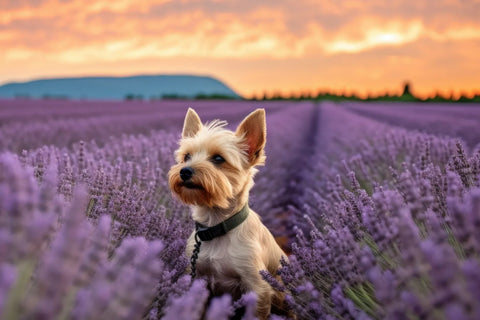
Do Dogs Dream? What We Know About Pup Naps
As pet parents, we've all witnessed it: our beloved pups, snug in their favorite spot, paws twitching, eyes flickering beneath closed lids, and the occasional soft whimper. What unfolds in their dreams?
At A Pup Above, where dog health and nutrition matter most, we dive into the captivating world of dog dreams. Join us in exploring the intriguing world of pup naps and uncover the secrets of sleeping dogs.
How Do Dogs Sleep?
Grasping the basics of dog sleep is the key to unveiling the mysteries of pup dreams. Like humans, dogs go through distinct sleep stages, including the Rapid Eye Movement (REM) phase.
During REM sleep, a dog's brain activity closely resembles their awakened state, making it the prime time for dreams, often marked by those flickering eyes beneath closed lids. Beyond REM sleep lies slow-wave sleep, constituting the bulk of a dog's sleep.
Here, brain activity significantly slows in a deep, restorative rest. Understanding these sleep stages illuminates the significance of REM sleep and the potential for vivid dreams.
Canine Dreaming: Is it Fact or Fiction?
For ages, whether dogs dream has fascinated pet owners and researchers alike. Do those subtle sleep movements, whimpers, and twitches hint at dreams, or are they reflexes? Let's separate fact from fiction in canine dreams.
Esteemed experts like Stanley Coren and Matthew Wilson have ventured into the world of canine dreams, offering compelling proof that dogs do indeed dream. Their research has looked into the canine mind, providing a glimpse into what happens behind those closed eyelids during sleep.
Stanley Coren, an authority on dog behavior, suggests that dogs likely dream due to similar sleep patterns with humans. Matthew Wilson's studies unveil intriguing links between brain activity and sleep experiences, hinting that our dogs' dreams may be as vivid and meaningful as our own.
Despite scientific support, misconceptions persist. Some believe dogs experience random, inconsequential brain activity during sleep. Yet, understanding a dog’s brain structure and sleep patterns makes the notion of dog dreams far more plausible.
What Do Dogs Dream About?
One question naturally arises: What do dogs dream about during sleep? While we can't directly access their thoughts, some clues offer insights into their dreams.
We can observe their behaviors during sleep to gain glimpses into dog dreams. You might have noticed your dog twitching, whimpering, or even moving their legs as if chasing something. These actions often mirror behaviors exhibited while awake, providing hints about the content of their dreams.
Unraveling the mysteries of dog dreams involves considering their connection to their waking experiences. Dogs often have a very solid and dependable daily routine, and their dreams frequently echo these realities.
Picture a scenario where your dog chases a ball at the park. During REM sleep, they may relive those moments, racing through fields and playfully leaping after an imaginary ball. This link between dreams and real-life experiences underscores the richness of our dogs' inner worlds.
How Does Size and Age Affect Dreams?
Dogs come in all shapes and sizes, each with unique personalities and quirks. To better understand canine dreams, we must consider how size and age influence their dream patterns and content.
Size Matters: Small vs. Large Dogs
Does your dog’s size affect their dreams? It's a captivating question that we aim to explore. Although limited scientific research exists, anecdotal evidence suggests that small dogs and large dogs may exhibit varying dream patterns.
Smaller breeds like Chihuahuas or Dachshunds often display more frequent dreams, possibly due to their petite frames and high energy levels. Larger dogs like Great Danes or Saint Bernards experience longer dreams influenced by their extended sleep cycles.
Age and Dreams
Just as humans' dream patterns change throughout life, dogs' dreaming habits also evolve with age. Energetic puppies likely dream of play, while adult dogs may dream of familiar activities and companions.
Our commitment to providing informative content extends to all dog owners, whether they have a lively puppy or a wise, elderly companion. Understanding how age shapes our dogs' dreams helps us appreciate their evolving needs and experiences.
What Do the Scientists Say?
While dog dreams may be a delightful topic for speculation, science offers a valuable perspective that helps us better understand the mysteries of canine sleep and dreams. At A Pup Above, detailed information about pet health is highly regarded, so we’re delving into the scientific side of dog dreaming for a closer look at what happens when they nap.
Harvard and MIT Research
Prestigious institutions like Harvard and the Massachusetts Institute of Technology (MIT) have contributed significantly to our understanding of dog sleep and dreams. Their research sheds light on the intricate workings of a dog's brain during different sleep stages.
Harvard's studies have revealed fascinating insights into the similarities between human and canine sleep patterns. Research at MIT has explored the connections between brain activity and the experiences of our four-legged companions during sleep. These findings have opened new windows into the possibilities of dogs experiencing dreams as vivid and meaningful as ours.
Insights From DVMs
Veterinarians, or DVMs (Doctors of Veterinary Medicine), are vital in deciphering dog sleep and dreams. DVMs bring clarity to pet health questions, including dog dreams, helping us provide accurate, trustworthy information.
Exploring the scientific perspective enriches our understanding of our beloved dogs while deepening our understanding of our beloved canine companions. If you are concerned about your dog’s sleeping or dreaming behaviors, it is wise to consult your own veterinarian for more information.
Embracing Dog Dreams: A Journey of Understanding
In the world of dog dreams, there's a blend of curiosity and science, fiction and fact. At A Pup Above, where palatability, flavor, and nutrition are paramount, we've embarked on a journey to uncover the secrets of “pup naps” and REM sleep.
As we've delved into the stages of dog sleep, brain activity during slumber, and the factors that influence dream patterns, one thing becomes abundantly clear — our dogs are more complex than we often give them credit for. Just as our commitment to pet health is unwavering, so too is our commitment to fostering a deep understanding of our furry friends.
While we may never fully grasp the exact content of our dogs' dreams, we can cherish the connection between their nighttime reveries and their real-life experiences. We encourage dog owners to interpret their pets' behaviors during sleep and celebrate the human-canine bond that is strengthened through cuddles during naptime.
In exploring this scientific perspective on dog dreams, we've uncovered new dimensions to our pets' lives, deepening our appreciation for the joy they bring us. Thank you for joining us, and remember, whether your dog dreams of chasing balls or simply enjoying your company, A Pup Above is here to support you in nurturing your furry friend's health and happiness.
Sources:
Sleep: What It Is, Why It’s Important, Stages, REM & NREM | Cleveland Clinic
Adventures in dog research with Stanley Coren | American Psychological Association
Why Your Dog Needs a Routine at Every Stage of Life | American Kennel Club
Animals have complex dreams, MIT researcher proves | MIT News
Top Stories

Why Do Dogs Lick Their Paws?

Why Do Dogs Whimper & Make Noises in Their Sleep?

Healthy Vet-Approved Homemade Dog Food Recipes

How To Cook Sweet Potatoes for Dogs






















